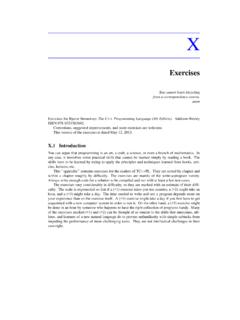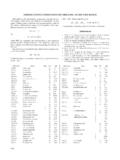Transcription of An Overview of the C++ Programming Language
1 FromThe Handbook of Object Technology (Editor: Saba Zamir). crc press LLC, Boca Raton. 1999. ISBN Overview of the C++ Programming LanguageBjarne StroustrupAT&T LaboratoriesFlorham Park, NJ07932-0971, USAABSTRACTThis Overview of C++presents the key design, Programming , and Language -technical con-cepts using examples to give the reader a feel for the Language . C++is a general-purposeprogramming Language with a bias towards systems Programming that supports efficientlow-level computation, data abstraction, object-oriented Programming , and generic Introduction and OverviewThe C++ Programming Language provides a model of memory and computation that closely matches that ofmost computers.
2 In addition, it provides powerful and flexible mechanisms for abstraction; that is, lan-guage constructs that allow the programmer to introduce and use new types of objects that match the con-cepts of an application. Thus, C++supports styles of Programming that rely on fairly direct manipulationof hardware resources to deliver a high degree of efficiency plus higher-level styles of Programming thatrely on user-defined types to provide a model of data and computation that is closer to a human s view ofthe task being performed by a computer.
3 These higher-level styles of Programming are often called dataabstraction, object-oriented Programming , and generic paper is organized around the main Programming styles directly supported by C++: 2 The Design and Evolution of C++describes the aims of C++and the principles that guided its evolu-tion. 3 The C Programming Modelpresents the C subset of C++and other C++facilities supporting tradi-tional systems- Programming styles. 4 The C++Abstraction Mechanismsintroduces C++ s class concept and its use for defining new typesthat can be used exactly as built-in types, shows how abstract classes can be used to provide inter-faces to objects of a variety of types, describes the use of class hierarchies in object-oriented pro-gramming, and presents templates in support of generic Programming .
4 5 Large-Scale Programmingdescribes namespaces and exception handling provided to ease the com-position of programs out of separate parts. 6 The C++Standard Librarypresents standard facilities such as I/O streams, strings, containers ( ve ec ct to or r,l li is st t, andm ma ap p), generic algorithms ( so or rt t(),f fi in nd d(),f fo or r_ _e ea ac ch h()) and support fornumeric round off, a brief Overview of some of the tasks that C++has been used for and some suggestions forfurther reading are The Design and Evolution of C++C++was designed and implemented by Bjarne Stroustrup (the author of this article) at AT&T Bell Labora-tories to combine the organizational and design strengths of Simula with C s facilities for systems pro-gramming.
5 The initial version of C++, called C with Classes [Stroustrup,1980], was first used in 1980;it supported traditional system Programming techniques ( 3) and data abstraction ( ). The basic facili-ties for object-oriented Programming ( ) were added in 1983 and object-oriented design and pro-gramming techniques were gradually introduced into the C++community. The Language was first madecommercially available in 1985 [Stroustrup,1986] [Stroustrup,1986b]. Facilities for generic Programming ( ) were added to the Language in the 1987-1989 time frame [Ellis,1990] [Stroustrup,1991].
6 As the result of widespread use and the appearance of several independently-developed C++- 2 -implementations, formal standardization of C++started in 1990 under the auspices of the AmericanNational Standards Institute, ANSI, and later the International Standards Organization, ISO, leading to aninternational standard in 1998 [C++,1998]. During the period of standardization the standards committeeacted as an important focus for the C++community and its draft standards acted as interim definitions ofthe Language .
7 As an active member of the standards committee, I was a key participant in the further evolu-tion of C++. Standard C++is a better approximation to my ideals for C++than were earlier versions. Thedesign and evolution of C++is documented in [Stroustrup,1994] [Stroustrup,1996] and [Stroustrup,1997b].The Language as it is defined at the end of the standardization process and the key design and programmingtechniques it directly supports are presented in [Stroustrup,1997]. C++Design AimsC++was designed to deliver the flexibility and efficiency of C for systems Programming together withSimula s facilities for program organization (usually referred to as object-oriented Programming ).
8 Greatcare was taken that the higher-level Programming techniques from Simula could be applied to the systemsprogramming domain. That is, the abstraction mechanisms provided by C++were specifically designed tobe applicable to Programming tasks that demanded the highest degree of efficiency and aims can be summarized:_ _____Aims:_ _____ _____C++makes Programming more enjoyable for serious ++is a general-purpose Programming Language that is a better C supports data abstraction supports object-oriented Programming supports generic programming_ _____ Support for generic Programming emerged late as an explicit goal.
9 During most of the evolution of C++, Ipresented generic Programming styles and the Language features that support them ( ) under the headingof data abstraction. Design PrinciplesIn [Stroustrup,1994], the design rules for C++are listed under the headingsGeneral rules,Design-supportrules, Language -techn ical rules, andLow-level Programming support rules:_ _____General rules:_ _____ _____C++ s evolution must be driven by real ++is a Language , not a complete t get involved in a sterile quest for ++must be feature must have a reasonably obvious provide a transition comprehensive support for each supported t try to force _____ Note the emphasis on immediate utility in real-world applications and the respect for the skills and prefer-ences of programmers implied by the last three points.
10 From the start, C++was aimed at programmersengaged in demanding real-world projects. Perfection was considered unattainable because needs, back-grounds, and problems vary too much among C++users. Also, notions of perfection change significantlyover the lifespan of a general-purpose Programming Language . Thus, feedback from user and implementerexperience is essential in the evolution of a 3 -_ _____Design-support rules:_ _____ _____Support sound design facilities for program what you features must be is more important to allow a useful feature than to prevent every composition of software from separately developed _____ The aim of C++was to improve the quality of programs produced by making better design and program-ming techniques simpler to use and affordable.














